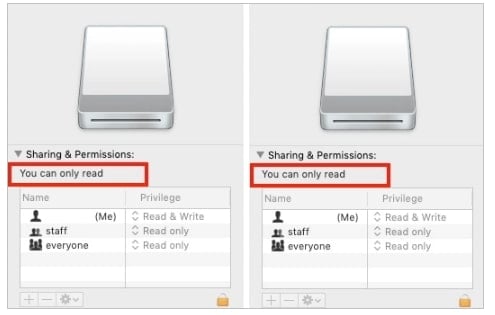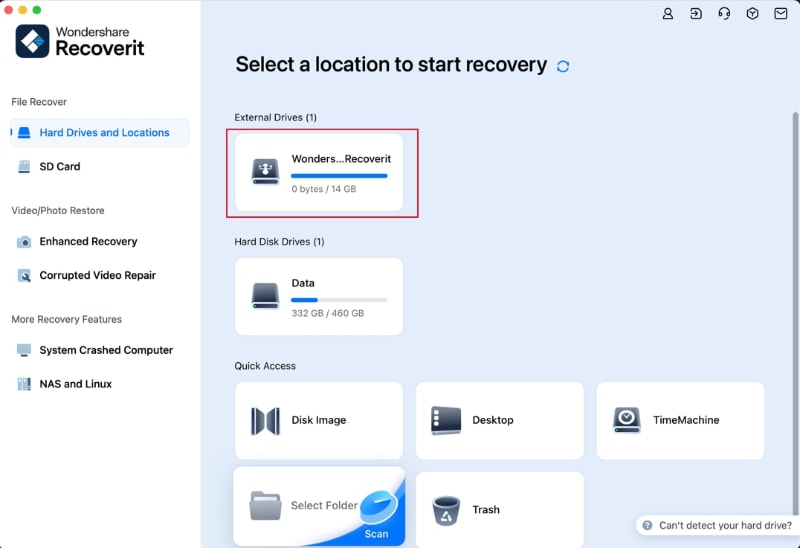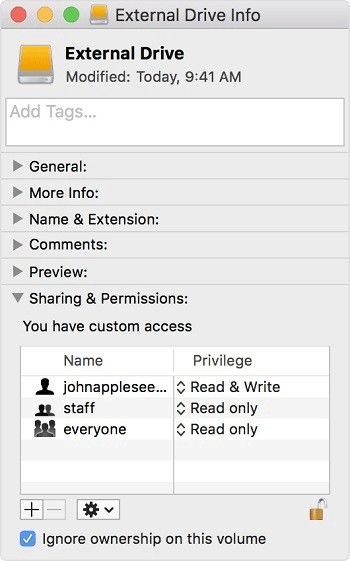It's a common frustration: you plug in your drive, and suddenly your Mac external hard drive is read-only, preventing you from editing, saving, or deleting files. This issue can happen for several reasons, but the good news is that most of them are easily fixable without data loss.
This comprehensive guide will walk you through the primary causes of the read-only problem, from simple permission settings to file system conflicts like NTFS. We will provide effective, step-by-step solutions to help you regain full read-and-write control over your external hard drive.
Table of Content
-
- Change the External Hard Drive Read-only Permission on Mac
- Ignore Permission Settings to Fix You Can Only Read an External Hard Drive on Mac
- Repair Your Read-Only External Drive Using Mac Disk Utility
- Reformat Your Read-Only Hard Drive on Mac
- Enable NTFS External Drive Format Write Support Using Terminal
Why Is My External Hard Drive Read Only on Mac
There could be several reasons why you can only read an external hard drive on a Mac. Here are the three most common ones.
Formatting Problems
All hard drives can have formatting errors, leading to various problems. One of the side effects is locking your external hard drive in read-only mode. If you see a message warning you that your external device is mounted for read-only, the formatting errors prevent any writing actions on your drive.
Permission Settings
External hard drives are also subject to permission settings of your OS, just like your local hard drive. These permissions affect all the folders and files on the device.

If you use the drive on another Mac with a different OS, it might be unable to recognize and adjust the permissions. In other words, you don't have permission to write to the external hard drive on this Mac and won't be able to use your drive as usual.
The External Hard Drive Has the NTFS Format
Your drive's file system format plays a crucial role, as macOS doesn't support all of them. More precisely, macOS doesn't work with the NTFS format. This incompatibility can cause different issues, but putting your hard drive permanently in read-only mode is the most common one.
The NTFS format is exclusive to Windows devices, and even though Macs can usually read these drives and their content, you won't be able to write to an NTFS external drive on macOS. Check if your device has the NTFS format by right-clicking it and left-clicking Get Info.
Before Fixing Your Read-Only External Drive on Mac
Since the problem has different causes, the solutions also differ. However, before you get to the fixes, you must make preparations. First, when dealing with the problem, you might lose data on that drive, so recover it before doing anything else.
- Recover and Back Up All Your Data
Making sure you don't lose any of the data on your external hard drive is essential. Luckily, you can quickly get a dedicated data recovery tool for Mac and use it to recover data in several short steps. In this tutorial, we have chosen Wondershare Recoverit because it is very simple to use and has been selected as a leader in data recovery by G2 users due to its advanced data recovery algorithm.
No matter what kind of data you have on your drive, you can rely on this tool to do the job. Here are the steps for Mac external hard drive data recovery:
- Download and install Wondershare Recoverit on your Mac computer.
- Start Wondershare Recoverit and select Hard Drives and Locations in the left sidebar.
- Select your external hard drive under External Drives.

- Wondershare Recoverit will automatically scan for data stored on the selected drive.

- Once the scan is complete, click the files to preview them and click Recover in the bottom right corner to recover the files.

- Check if You've Connected Your External Drive Correctly
It might sound obvious, but many people focus so much on software issues that they don't check the hardware elements. External drives usually use an HDMI or USB cable, so check yours to see if you've plugged it in correctly.
Once you do, check the cable for any physical issues. If needed, disconnect it from the drive and the computer and reconnect it while switching the ports. If you have a different hardware nearby, try replacing it and testing if it works.
- Check Your Drive for Physical Damage
Checking your external hard drive for irregularities is always a good idea. First of all, inspect it for any visible damage. Apart from the visual elements, you should also listen to your drive and look for unusual noises like buzzing, beeping, grinding, or clicking.
Top 5 Ways to Fix a Read-Only External Hard Drive on Mac
Here are the five ways to fix your read-only external hard drive on a Mac.
Way 1. Change the External Hard Drive Read-only Permission on Mac
Permissions can be set on a file, folder, or entire hard drive to determine who has access and what actions they can perform on them. It's a common security feature used by those that wish to protect their work.
This is often the cause of read-only errors when one of the external hard drive's previous users or owner must've set read-only permissions on it. whether intentional or by accident, setting the external hard drive's permissions to read-only means you can't perform any write actions.

Here's how to change the external hard drive permissions back to "Read & Write":
- Connect the read-only external hard drive to your Mac.
- Right-click the drive's icon on the desktop and select Get Info to view the drive's details.
- At the bottom of the drive info window, click on the golden padlock if it's locked.
- Enter your Mac administrator password to unlock the hard drive's permission settings.
- Look under Sharing & Permissions to find a list with your user account name along with the staff and everyone groups with their current permissions.
- Click the drop-down menu beside the account or group name whose permissions you wish to change and pick "Read & Write" permission.
- If your account name isn't listed in the Name column, click the Add button
 to add your account to access this drive.
to add your account to access this drive. - After updating the hard drive's permissions, click the gear icon below the permissions list and select Apply to enclosed items. This will prevent permission conflicts.
Way 2. Ignore Permission Settings to Fix You Can Only Read an External Hard Drive on Mac
Another way to solve the external hard drive read-only error on Mac is to ignore permissions. This is only effective if you are sure that the problem is being caused by the hard drive's permission settings and your Mac can't write to the external drive.
Just like in the case of changing permissions, someone has set access to the hard drive to read-only for whatever reason. However, unlike the previous solution, this one will show you how to completely ignore the permission settings. Here's how you do it:
- Open your Finder and find your external hard drive under Locations.
- Right-click the external drive and click Get Info.

- Switch to the Sharing & Permissions tab and click the padlock icon for authentication.

- Untick the Ignore ownership on this volume feature checkbox.

Way 3. Repair Your Read-Only External Drive Using Mac Disk Utility
You can fix formatting and other errors that might be causing read-only issues in your external hard drive with Disk Utility:
- Open Finder and go to Applications > Utilities.
- Start Disk Utility.
- In the left sidebar of Disk Utility, you will see your external drive listed. Select it.
- Click on the First Aid button located at the top of the Disk Utility window and hit Run.
- Disk Utility will check the drive for errors and attempt to repair them. This process may take a few minutes.
- Once the process has finished, you will see a report showing any issues found and the actions taken to fix them. If the report says the drive appears to be okay, then the repair was successful. If the report mentions any problems that could not be fixed, it may be necessary to reformat the drive or seek professional assistance.
- If the repair was successful, click Done to close the First Aid windo

Your external drive should now be working properly, and you should be able to read and write files on it. If you continue to experience issues with your external drive, consider backing up your data and reformatting the drive. If the problem persists, it may be necessary to seek professional assistance or replace the drive.
Way 4. Reformat Your Read-Only Hard Drive on Mac
If the external hard drive is empty, or you have a backup of all its contents, an easy way to resolve the read-only issue on your Mac external hard drive is by formatting it. This means clearing everything on the hard drive and turning it into a clean slate. The method of reformatting your hard drive will be able to restore read and write permissions to your external device on macOS, especially if the issue is due to it using an NTFS file system.
There are three different formats to choose from when using this fix, so make sure you pick the one that suits your needs. Here are the options you have:
| File System Formats | Compatibility |
| APFS | Format your external hard drive to APFS if you plan to use it on a Mac with macOS 10.13 High Sierra or later. |
| HFS+ | Also known as Mac OS Extended, HFS+ can be used if you intend to use the external hard drive on macOS Sierra and earlier Mac operating systems. Later versions of this format added journaling to prevent a drive's file system structure from becoming corrupt. |
| exFAT or FAT32 | Also known as MS-DOS, this format is compatible with both Mac and PC, so if you intend to format your hard drive for both Mac and PC, pick this. The other two file systems mentioned above are only compatible with Mac. |
Once you have determined the file format, follow these steps to fix the issue of external hard drive not writable on Mac:
- Open Finder, go to Applications > Utilities, and launch Disk Utility.
- In the left sidebar of Disk Utility, you will see your external drive listed.
- Click the external drive and hit Erase in the action pane.

- Specify the formatting details, including the file system (APFS, Mac OS Extended, FAT, or exFAT) and scheme (e.g., GUID Partition Map). Once you're ready, click Erase, and formatting will start.

Your external hard drive should now be formatted and no longer read-only. You can now read and write files on the drive. Remember to transfer your backed-up data back to the external drive if needed.
Way 5. Enable NTFS External Drive Format Write Support on Mac Using Terminal
This method will require a familiarity with your Mac's command-line interface. The Mac Terminal provides Mac users with total customization and command options, like modifying your fonts, desktop files, and more. Due to the Mac Terminal's more technical nature, it should be one of your last options and used with caution. This is especially the case for novices as any accidental inputs could cause damage to your Mac.
Using the Mac Terminal, you will be able to change the external hard drive's file format from NTFS to something more compatible with your Mac. However, make sure you know what you're doing and don't make any guesses.
Here's how to fix your external hard drive read-only error on Mac using Terminal.
- Start Finder, click Applications, and enter the Utilities folder to access Terminal.

- Run the
sudo nano /etc/fstabcommand to edit the fstab file.
- After entering your account name and password, run this command:
LABEL=DISKNAME none ntfs rw, auto, nobrowse. TheDISKNAMEvalue should be your external drive's name (use the same name that appears in Finder). For example, if your drive's name is "Tracy", the line should look like this:LABEL=Tracy none ntfs rw,auto, nobrowse
- Once you have added the line, press Control + O to save the changes, followed by Control + X to exit the Nano editor.
- Unmount and disconnect your external drive, then reconnect it to your Mac.
- Since the
nobrowseoption was used in the fstab file, the drive will not appear on your desktop or in the Finder sidebar. To access it, open Finder, click on Go > Go to Folder or press Shift + Command + G. - In the Go to Folder window, type /Volumes and click on Go.
- You should now see your NTFS drive in the Volumes folder. You can create an alias (shortcut) to this location for easier access in the future.
Now you should have write access to your NTFS external drive on your Mac. Keep in mind that this method uses Apple's experimental NTFS write support, which may not be as reliable as third-party solutions like Paragon NTFS or Tuxera NTFS. Use it at your own risk and always keep a backup of your important data.
Conclusion
We've covered the five best options for fixing the "Mac external drive read-only" issue. Try changing permission settings, formatting your drive into a different file system, enabling NTFS external drive write support, and repairing your drive using Disk Utility.
Remember to recover the data from your drive using a recovery tool before doing anything to ensure you don't lose any valuable files or information. If you can't deal with the issue, we recommend visiting the nearest professional Mac repair shop.
FAQs About External Hard Drives Being Read-only on Mac
-
Why does it say you can only read my external hard drive on Mac?
The most common reason is that the drive is formatted with the NTFS file system, which is native to Windows. By default, macOS can read files from NTFS drives, but it cannot write to them. This is the primary cause when you can only read an external hard drive on a Mac. -
How do I change a hard drive from read-only on a Mac without formatting?
First, select the drive icon and press Command + I to "Get Info." At the bottom, check the "Sharing & Permissions" tab and ensure your user account has "Read & Write" access. If this doesn't solve the hard drive read only on Mac issue, it's likely an NTFS problem that requires a specific driver. -
Can a corrupted drive cause the read-only error on a Mac?
Yes. If the drive has file system errors, macOS may mount it in read-only mode to prevent further damage. You can try to fix this by running "First Aid" from the Disk Utility application. This can often resolve issues when your Mac can't write to an external drive due to corruption. -
Will I lose my data if I fix the read-only permission?
You will only lose data if the solution requires you to reformat the drive. Methods like changing permissions, using Disk Utility's First Aid, or installing an NTFS driver will not erase your files. Always back up your data if you decide formatting is the only option left.



 ChatGPT
ChatGPT
 Perplexity
Perplexity
 Google AI Mode
Google AI Mode
 Grok
Grok























